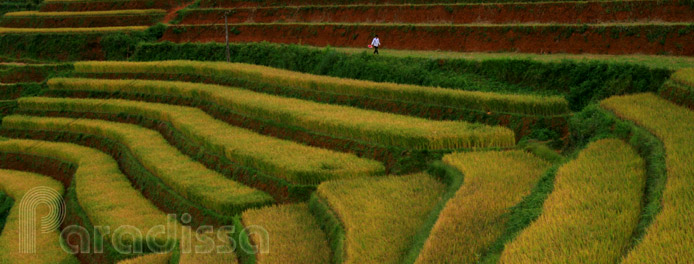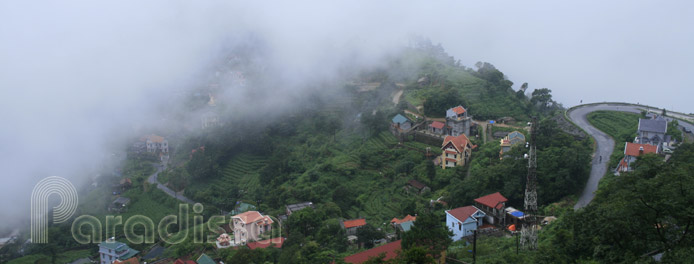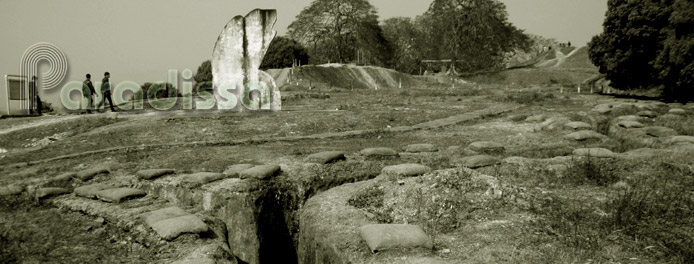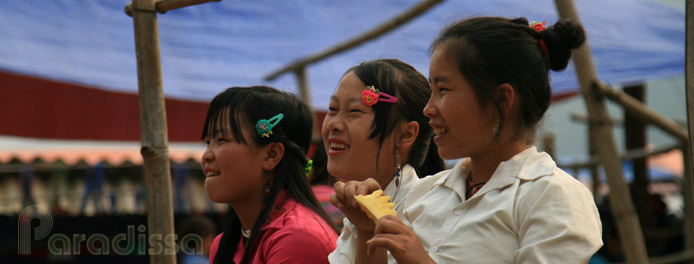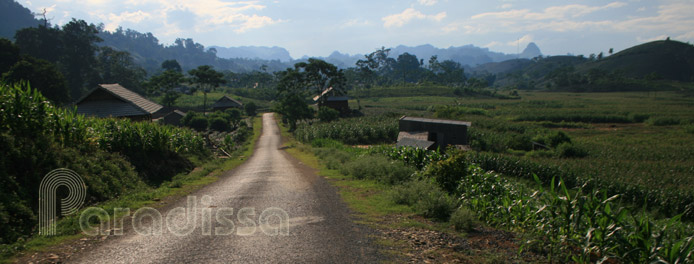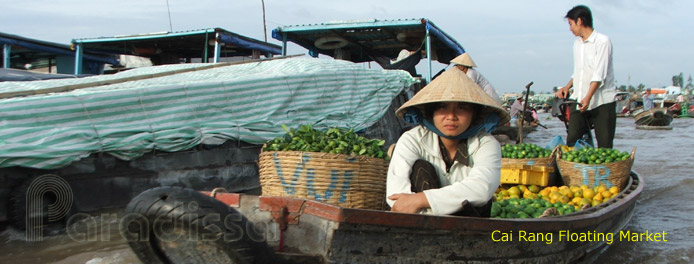Vietnamese food is much better known today thanks to the country’s growing tourism. Travelers who have been to the country often find one of the highlights of their trip to Vietnam is the Vietnamese cuisine which bears some influence of of its neighbors Chinese food, Thai food, Lao food, Khmer food. And of course the Vietnamese food is also much influenced by French food as it was under the French rule for a long time.
As a foreign visitor to Vietnam, you are more likely to be overwhelmed by a wide array of dishes going to a Vietnamese restaurant for the first time. Below Paradissa’s foodies have a list of popular dishes in the country that could help you to get familiarized with local food and hence a more enjoyable vacation in Vietnam.
 CƠM (boiled/steamed rice)
CƠM (boiled/steamed rice)
In Vietnam, steamed rice is the stable food for thousands of years. Steamed rice is cooked by boiling rice submerged in water. When the rice is cooked by the boiling water and the heat of the steam. By the time the water evaporates completely the rice should be properly cooked.
At meals, steamed rice is accompanied by several other dishes: meat, herbs, broths, vegetables,...
CHAO (Porridge, rice soup)
Chao is cooked by boiled rice in several hours until it becomes and thick and sticky liquid. When you put it in the mouth, then you no longer feel the rice grains but all makes a fine texture. You may think that this is is soup which should be finely cooked from rice flour but the tastes of the two dishes are not the same.

Porridge with mung beans
There are several of porridge variations: with mung beans, with chicken, topped with sauteed eels,...
XOI, COM NEP (Steamed Sticky Rice)

Sticky rice with fried egg
 BÁNH CHƯNG (Sticky Rice Cake)
BÁNH CHƯNG (Sticky Rice Cake)
Sticky rice cakes are the must-haves for every Vietnamese family for Tet celebration (The Lunar New Year). Making Banh Chung is a long and enduring process. Cooking Banh Chung is more often an overnight experience which is a special occasion for Vietnamese family reunions. The first Banh Chung should be put on the family altar as offerings to the ancestors, then the family can have it at the first meal for the New Year Celebration which could be on the last day of the old year or on the first day of the New Year.
BÁNH CUỐN (Rice Flour made into paper, steamed and rolled)
Banh Cuon can be found all over Vietnam be it in the mountains or in the deltas, in the country or in cities. This is a really healthy Vietnamese dish. Banh Cuon can be for breakfast or can be for snacks.
The food is made by grinding rice and pouring water on the grinder at the same time. The batter, a thick white liquid, then is spread thinly on a cloth which rests on a flat bamboo frame on a saucepan containing boiling water. The hot steam forms and cooks the rice paper. The chef then uses a flat-surface bamboo stick to take the rice paper off the cloth and put it on a plate where is is rolled up into parcels being filled with minced pork, wood ears, peppers…
Banh Cuon should be dipped in a special sauce called Nuoc Cham before eaten. The sauce should be heated and sprinkled with scallions, pepper and chili. The accompaniments include sliced fried pork paste, omelet or fried eggs. The dish should be eaten when it is hot.
BÁNH TÔM (crispy shrimp pastry)

The fried pastry topped with crispy shrimp is served right off the frying wok. The dish should be accompanied by sliced vegetables dipped in sweet and sour sauce.
BÚN (rice vermicelli)
Vietnamese vermicelli is a healthy and yummy dish. There are different dishes which use vermicelli as the base which is accompanied by either grilled pork (Bun Cha), or snail soup (Bun Oc), or a soup of pork meat balls (Bun Moc), or thin slices of fried pork paste (Bun Thang), or fresh water crab soup (Bun Rieu Cua)… The soup is an important element of the whole dish. In case of Bun Oc and Bun Rieu, it is recommended to add some fermented shrimp paste into the soup before eating as this makes the smells and flavors more fulfilled.
Bún Chả (noodles with grilled pork patties)
Bun Cha (noodles with grilled meat) is a delicacy you should not miss when traveling in Vietnam. Bun Cha is accompanied by several types of herbs. The most important elements of good Bun Cha are:
- the pork quality;
- the skill of the cook who grills the pork;
- the dipping sauce with different herbs.
The grilled pork includes seasoned batty and minced marinated pork. Depending on the diner’s taste that which type of the pork is served.
The accompaniments to Bun Cha include sliced kohlrabis (or papayas), sliced carrots, sliced chili, smashed garlic in sweet and sour sauce (Nuoc Cham). 
CANH CHUA (Sour Fish Broth)
Vietnam has various Canh Ca Chua dishes depending on the three regions of the country. The main difference is the flavors and aroma of regional herbs. The sour flavors are formed by either tamarinds, tomato or Qua Doc (from Garcinia multiflora trees).
CHẢ CÁ (grilled minced fish)
Grilled minced fish has been served in the Old Quarter of Hanoi for several years. The fish used for the dish are either catfish or snake-headed fish which have few tiny bones. The preparations of the raw materials require skillful hands which can take off all the bones and cut the fish into clean pieces.
Then they marinate the fish pieces in salt and spices to ensure flavors and pleasing scents. This process requires experience of the cook else it’d be too salty or not tend to retain the fresh flavors. The final process is to grill the minced and marinated fish.
Dining Cha Ca is a cozy experience. The already grilled minced fish is put in a little sizzling frying pan on a burning charcoal stove.
The aromatic herbs as accompaniments are fresh lettuce, dills. The dipping sauce can either be fish sauce or fermented shrimp paste sprinkled with hot chili. The later is preferred as it enhances the smell and flavors of the dish.
 CHẠO TÔM (Grilled Shrimp Paste)
CHẠO TÔM (Grilled Shrimp Paste)
Grilled or baked shrimp paste are made by grinding shrimp adding coconut juice to make the paste. The paste then is wrapped around a piece of sugarcane. Then the cook can either bake it or roast it over charcoal.
CỐM (drily fried young rice)
Com is mostly cooked and eaten as snacks in fall in North Vietnam when the temperatures are pleasant. Com is cooked from sticky rice grains which are harvested 2-3 weeks before the rice ripens completely. During this time, the grains are still soft and provide the best fragrance.
The grains are then threshed from the plants and cleaned and roasted in low temperatures for 30 minutes. The roasted rice then put into foot-operated rice pounders for dehusking. The cook then uses a basket to separate the grains and the husks from the mixture after it is pounded. The food obtained is Com which is soft, chewy and which has lovely smell. Com is wrapped and served in lotus leaves which preserve and enhance the fragrance. Com is eaten with banana.

Com Tu Le in Yen Bai Vietnam (dry fried unripe sticky rice)
CƠM HẾN (Mussel Steamed Rice)
Com Hen is a typical dish of Hue, in the Central Region of Vietnam. The food includes steamed rice and stir-fried mussels (or basket clams). The cook boils the mussels then takes the flesh off the shells and put it in a basket. The water left will be used as broth for the meal.
The mussel flesh is marinated and seasoned with ginger, hot chili and pepper before being stir-fried with dry shallots. Add some laksa leaves to the food. Add some fermented shrimp paste to the broth and heat in lower fire until simmering. Throw in some chopped laksa leaves and coriander into the broth. There you go to have Com Hen and accompaniments include peanuts, herbs, pig skin crackers.
GIÒ LỤA (Lean Pork Paste Pie)
Gio Lua is made by pounding lean pork for hours until it becomes fine sticky paste. The paste is seasoned with a drizzle of fish sauce and black pepper, wrapped into cylindrical shape by banana leaves, then boiled for hours until it is completely cooked. Gio Lu is present at meals on all important occations in Vietnam.
CHA (fried pork paste)
Cha is made by a similar method as Gio. The pork paste shall be spread on a flat-bottom bamboo basket so that it is about 1-1.5cm thick. The dish is then fried on a pan in cooking oil.
Sometimes people season the port Cha with cinnamon or dill to make it more flavorful and aromatic.

Wet rice paper (Banh Cuon) with Cha (fried pork paste)
CHA COM (Fried pork paste mixed with rarely roasted young rice)
Cha Com is a dish in northern Vietnam, mostly in Hanoi. Cha Com is made from fine sticky pork paste, coarsely ground pork, eggs and Com (young roasted sticky rice).
First we put Com into a saucepan and put eggs in it, then stir the mixture until it is finely mixed. Then put the pork paste and coarsely ground pork into the mixture and stir again. Add some hint of fish sauce to enhance the smell and flavors. Stir the whole mixture again. Then mold the mixture obtained into patties.
Put the patties onto a lotus leave which is put in a steamer for 10 minutes. Then, fry the patties in cooking oil.
Cha Com is eaten with vermicelli or steamed sticky rice with mung beans.
BÚN BÒ HUẾ (Vermicelli with beef)
Bun Bo Hue, a native soup of Hue, a vermicelli soup with steamed beef, pig bones, steamed blood cubes. The broth is obtained by boiling pork/beef bones for hours, then throw in fermented shrimp paste, a drizzle of fish sauce, a mixture of stirred fried chopped lemongrass and garlic.

Vermicelli beef - Hue style (Bun Bo Hue)
The dish is served in a bowl and topped with chopped scallions and sliced fresh onions. The accompaniments include lemon (or lime) slices, fresh chili, mint, threaded banana buds, threaded water spinach stalks.
LẨU MẮM (hot-pot)
Lau Mam is a flavorful soup seasoned with chili, vegetables, tamarinds, tomatos, elephant ear stalks,… depending on the taste of the diner. The soup is served in a saucepan which is cooked in the middle and the diners sit around. The other ingredients include seafood, fish, and beef which are all uncooked and are put on separate plates.
The diner (using chopsticks) puts the uncooked ingredient into the boiling broth and waits until it is well cooked and savors his food.

Hotpot

Raw fish for hotpot
LẨU NƯỚNG (grilled meat such as seafood, fish, beef, pork..)
Lau nuong is similar to Lau Mam which is served with a utensil for grilling or roasting food in the middle. Lam Mam has a broth but Lau Nuong has no broth. The tool for grilling/roasting is electric nowadays. The other ingredients include seafood (fresh squid, fresh shrimps, marinated beef, marinated pork chops,… There should be a dipping sauce for everyone or for each diner.
The accompaniments include a wide array of salads, herbs, pickled vegetables..
MIẾN (Noodle from a cassava-like tuber)
Mien is noodle made from the powder of a tuber called Dong Rieng. While rice noodle threads are opaque and really soft, Mien threads are translucent and chewy. Rice noodle threads bulge when cooked which is not the case with Mien.

Stir-fried Mien with seafood, purple cabbage and eggs
Mien is made into broths of which the most popular and common in families is Mien Soup with chicken intestine, kidneys, heart. The other ingredients of this dish are wood ear mushrooms, black pepper, chopped scallions. The dish is served hot right off the kitchen.
The other Mien dishes include Mien Xao Long Ga (stir-fried Mien with chicken intestine), Mien Ngan (broth with goose), Mien Luon (Mien soup with crispy fried eels)… Mien is especially good for people with diabetes who is advised not to eat much carb food.
 NEM RÁN/Cha Gio (Fried Spring Roll)
NEM RÁN/Cha Gio (Fried Spring Roll)
Nem Ran is made from rice papers, Mien, chicken eggs, wood ear mushrooms, minced pork, carrots, onions, bean sprouts, coriander, fish sauce, black pepper.
The filling is made by chopping up wood ear mush rooms (which have been dipped in warm water for a while), onions, bean sprouts, coriander. Put egg into this mixture and mix them up thoroughly before it is conditioned with fish sauce and black pepper. The carrots are julienned and mixed well with the above mixture to form the filling.
Use your hand and spread a translucent rice paper on a flat surface (bamboo basket or tray…) and put the filling on the top, wrap it up to make a spring roll. Put the parcel in boiling oil until is is completely cooked.
Nem is a traditional Vietnamese dish which was used only for special occasions like Tet (lunar new year) in the past. Nowadays the dish is popular and common at families’ meals at weekends or parties. Nem can be eaten with steamed rice or vemicelli.
Nem Ran must be served with a special dipping sauce is made from fish sauce, vinegar, sugar, chili, pepper...
Goi Cuon (Fresh Spring Rolls)

Vietnamese Fresh Spring Rolls (Goi Cuon)
Goi Cuon is similar to Nem which means it is made by wrapping a rice paper around a filling. The differences are
- the wrapped-up parcels are not fried or cooked afterwards but eaten straight away.
- The filling includes either cooked julienned pork, egg, shrimps mixed with aromatic herbs and vermicelli (fresh wet rice noodle) and julienned carrots.
Goi Cuon uses a similar dipping sauce as Nem Ran.
 NỘM (Salad)
NỘM (Salad)
Nom means Vietnamese salads with different variations.
The must-haves:
- Either grated turnip, kohlrabi, or papaya, banana bud shreds, and slices of cucumber, star fruits and carrots.
- vinegar, sugar, garlic, hot chilly, salt, cracked roasted peanuts,
The other ingredients make up different variations of Nom: steamed seafood, sauteed chicken soaked in lemon juice, grated unripe mango, purple cabbage, young jack fruits, shredded morning glory (water spinach)...
Nom is a lovely dish for warm summer days in Vietnam.
PHỞ (Fresh Wet Noodles) 
Pho is the most popular Vietnamese food served in restaurants in Vietnam. Pho is not normally cooked at home due to that you’ll need to buy a big amount of the wet noodle which is the base of the dish. Pho is usually served in soup and with either thin slices of beef or finely shredded steamed chicken.
The most important ingredient of Pho is the soup quality. Restaurants nowadays have 2 types of soup for the diners’ individual tastes: clear-water soup is not fatty and fatty soup. The smells and flavors of Pho are what of the soup.
Another important ingredient is of course the Pho noodle which should come in thin, smooth and fine threads. If the noodle threads are not thin and fine as often encountered in the mountainous regions in Vietnam, then food looses most of its beauty and textures.
TÔM CHUA (Hué Sour Shrimp)
Tom Chua sounds like pickled shrimps which taste sour, spicy, salty, sweet... all at the same time. The best Tom Chua is found in Hue, Da Nang and Hoi An. The ingredients include: fresh shrimps, sticky rice four, wine, shredded galangal, fresh chilis, slices of bamboo shoots, salt, sugar.
The shrimps are soaked in rice wine for 30 minutes.
The sticky rice flour is cooked into a thick liquid.
Put the shrimps and the accompaniments into a container or a glass jar, top it with guava leaves to ensure all is submerged. Put on the air-tight lid. Tom Chua should be ready after 3-5 days. Tom Chua is served with Pho or noodle soup and can be used as dipping sauce for sliced steamed pork with slices of unripe bananas...
Thang Co
Thang Co is the most popular dish among the ethnic people in the far North of Vietnam. Thang Co is cooked from all meat of an animal which could be a goat, a horse, a cow or a water buffalo. After the animal is slaughtered, all meats will be put into a huge vessel containing water which is kept boiling for many hours. In the past, the cooker for Thang Co was from the skin of the slaughtered animal. The clients will pay per person and get the food themselves into a plastic bowl. Thang Co is to be enjoyed with salt and strong corn or rice spirit.

Thang Co at an ethnic market in the far nothern Vietnam

A Hmong man is cooking Thang Co




